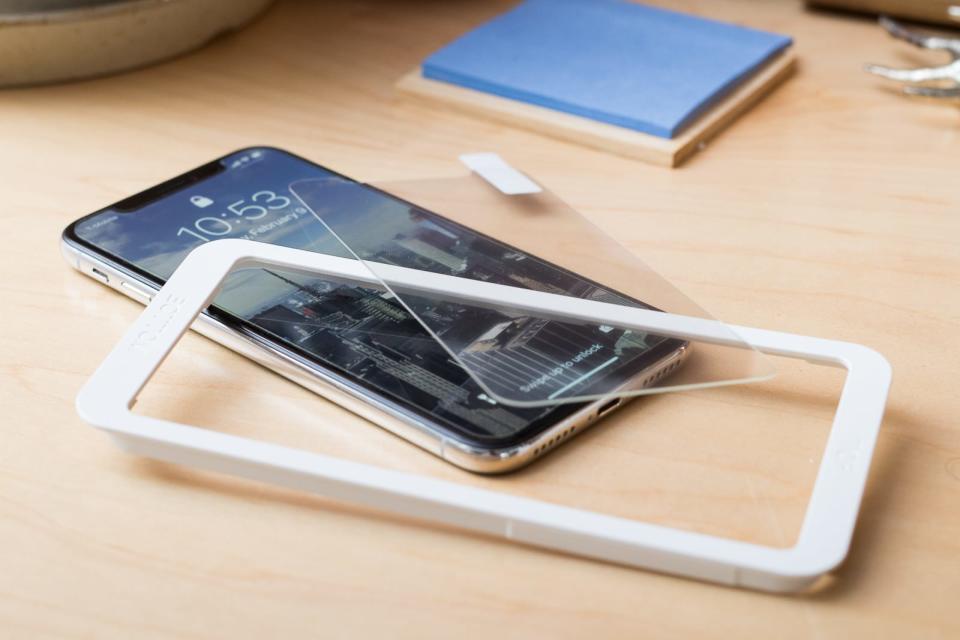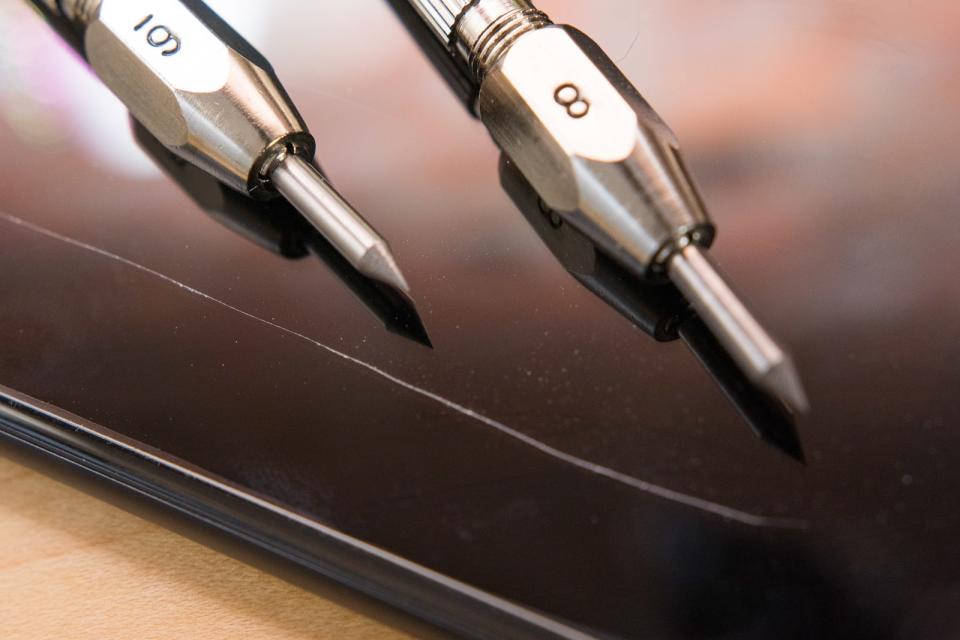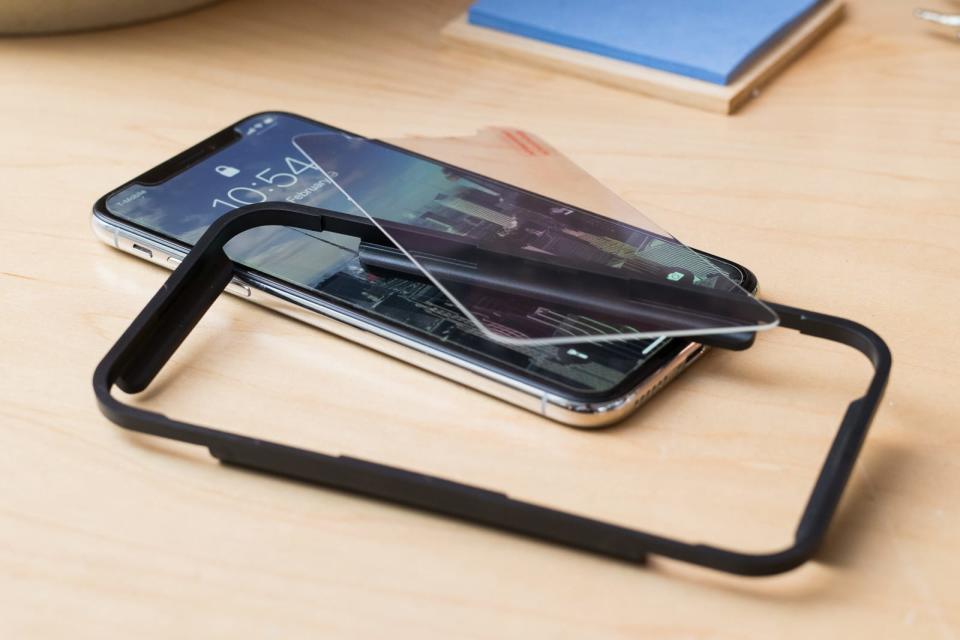The best iPhone screen protectors
Prevent scratches while your new phone is still pristine.

By Nick Guy
This post was done in partnership with Wirecutter. When readers choose to buy Wirecutter's independently chosen editorial picks, Wirecutter and Engadget may earn affiliate commission. Read the full guide to iphone screen protectors.
You don't have to spend as much as a few trips to the movies on a good glass screen protector for your iPhone—after testing six models, we found the affordable Maxboost Premium Tempered Glass Screen Protector to be the best for the iPhone XS/11 Pro, XS Max/11 Pro Max, and XR/11. It covers the entire active area of the iPhone's display, it's crystal clear, it's as scratch-resistant as anything else we tested, and fingerprints wipe right off. It includes a nice selection of cleaning tools, and we found installation to be easy enough. And if you get a speck of dust under the glass on your first attempt, it's not the end of the world—you get three Maxboost protectors in each package.
A glass screen protector can't guarantee that you won't break your iPhone's screen. But it can prevent the screen from getting scratched, and scratches can affect glass' structural integrity and make cracks more likely. Glass is more protective than film, and it comes closer to the look and feel of the iPhone's own display.
TechMatte's amFilm Tempered Glass Screen Protector for iPhone X/XS/11 Pro, XS Max/11 Pro Max, and the XR/11 uses similar glass as our top pick for the iPhone 8 and 8 Plus, but the included alignment tool has a little more wiggle room than the Maxboost protector for the iPhone X and later, making a perfect installation more difficult. It comes with three pieces of glass, though, meaning that if our pick goes out of stock or jumps in price, you can still get a great protector—and a few shots at a perfect installation—for a good price.
Why you should trust us
I've tested screen protectors for Wirecutter since 2016, and other protection accessories since 2014. Before that, I was the accessories editor at iLounge for a little over three years. During my tenure, I reviewed more than 1,000 products, including dozens of screen protectors across multiple models and generations of Apple devices, and the first glass screen protector (Spigen's GLAS.t for iPhone 4).
While researching this guide, we interviewed Matt Ham, who has a master's in mechanical engineering and is the founder and president of Computer Repair Doctor; Kyle Wiens, CEO of iFixit, likely the most well-known technology-repair advocate; Timothy Katsch, vice president of iDropped; and Mario Haas, head of development and application at Schott (a company that makes ultrathin glass).
Who should get this
As mentioned earlier, a glass screen protector is no guarantee against cracks. The sheer number of factors that can lead to a screen cracking—everything from the height of the drop to the angle at which the phone lands to the material it lands on to humidity (really!)—means that it's impossible to make this promise. Given that, is a screen protector worth your money?
"While screen protectors aren't perfect, they definitely help," said Computer Repair Doctor's Matt Ham. "The basic science is simple, adding an extra layer of tempered glass protects the original screen. The tempered glass screen protector is not an impenetrable force field of protection, it's an added layer of defense."
That last point is key: A screen protector may help prevent damage from a direct impact to the face of your phone (though it's not clear how much the protector does to cushion blows, rather than just help avoid scratches), but it's just a bit of added protection, not an impenetrable shield. And it won't do much to guard against blows to the corner or edge of the phone's body, which are far more common: Our friends at iFixit tallied the broken screens they had on hand and concluded that 75 percent of them had been damaged at the corner or edge. This means that a good case—we have guides to the best cases for the iPhone X, 7 and 8 series—is even more important than a screen protector: Paired with a case, an iPhone screen protector may help prevent damage to your phone.
But scratch protection is worthwhile, too. A phone with a scratched screen is less pleasant to use, and it will be worth less if you ever decide to sell it. More important, scratches weaken the structural integrity of glass. Kyle Wiens of iFixit told us, "A major factor in glass breaking is if anything has already scratched it. It's much easier to break scratched glass. So if the screen protector takes the scratch instead of your screen, then it reduces the likelihood the screen will break." Timothy Katsch of iDropped also said that microcracks can deteriorate glass, so it's better for an inexpensive and disposable glass screen protector to take this damage than the phone itself. "I do think glass protection glass films are a great invention," Mario Haas of Schott told us. "Such glasses form an additional protection shield against outside influences... If the protection glass film cracks, the display glass underneath stays intact. When that occurs, the protector can be easily replaced."
How we picked and tested

We focused on glass screen protectors because protective films are less scratch-resistant, take away from the look and feel of the iPhone's display, and have been largely supplanted by affordable glass protectors.
We skipped testing glass from well-known brands, including Belkin, BodyGuardz, and Zagg (Zagg also owns the InvisibleShield line). These protectors are widely available, but they're almost always expensive, and in our tests with glass protectors for previous iPhones, we found their glass to be of the same quality at best, and sometimes worse. More expensive protectors offer no benefits over the cheaper ones we recommend.
For each screen-protector model we tested, we followed the instructions in the box to install it on the iPhone X. We evaluated how clear the instructions were and how helpful any installation tools proved to be. Once the screen protector was in place, we visually inspected it to look for any obvious degradation of screen quality or brightness, and we ran our fingers along the perimeter, checking for obnoxiously sharp edges. We used the phone in a normal fashion to confirm that the protector didn't interfere with use of the touchscreen. During this use, we also observed how readily fingerprints showed on the protector, and then we wiped off the screen (using a cotton T-shirt) to see how easily we could remove those fingerprints.
We then broke out our Mohs hardness test kit. The Mohs test evaluates the hardness of a mineral based on if it can be scratched by a set of reference minerals, each rated on a scale from 1 (talc, the softest) to 10 (diamond, the hardest). This isn't the test that screen-protector manufacturers use or advertise; they instead rely on something called the ASTM Film Hardness by Pencil Test, which is a test designed for coated materials. We don't think the pencil test is the best way to evaluate screen hardness because even the hardest pencil in this test (9H) is softer than tempered glass, so any decent glass screen protector will get a 9H rating, and the pencil test thus won't reveal differences in scratch resistance between models. More important, many of the things that might scratch a screen or a screen protector are harder than a 9H pencil; the Mohs kit includes materials that can scratch tempered glass.
To confirm that the Mohs test would be valid, we asked Ivar Reimanis, PhD, Herman F. Coors Distinguished Professor of Ceramic Engineering and professor of metallurgical and materials engineering at the Colorado School of Mines. Although he did temper his response by saying that the Mohs test wasn't a perfect analogue to the pencil test, he concluded that "the ranking would be similar, since you are just evaluating the resistance to scratching with two different probes."
In the Mohs test, we started with the number 1 stylus, holding it at about a 70-degree angle and applying a moderate amount of force as we dragged it down the glass multiple times in varied directions. (We couldn't guarantee precisely consistent pressure across trials, but we did our best to use a similar amount of force each time. Unless two protectors were very close in their hardness, the variance in pressure was unlikely to hide the difference, as we saw little ambiguity in the tests—when something scratched, it was very evident.) For each screen protector, we repeated this test with increasing reference picks until a pick scratched the glass. We then recorded the number of the hardest stylus that didn't scratch the glass, along with the number of the stylus that did scratch it. Because we didn't have styluses with hardness ratings between integers, in this guide we note for each protector the range of hardness (for example, "between 6 and 7") that includes the actual scratch resistance of that model.
We didn't do any sort of drop tests with the screen protectors, because we don't think such tests are particularly relevant. Tests in which a heavy object, such as a ball bearing, is dropped directly onto the screen don't represent real-world scenarios—not to mention that an impact that breaks a screen protector may not have broken the phone's unprotected screen. (We couldn't easily measure the strength and hardness of that screen, and proprietary data on screen glass isn't available.) In addition, it's impossible to re-create every kind of impact a phone may suffer, so the results of a particular type of drop test can't be generalized to cover all scenarios.
Our pick for iPhone X and later: Maxboost Premium Tempered Glass Screen Protector

The best screen protector we've found is the Maxboost Premium Tempered Glass Screen Protector for the iPhone X/XS/11 Pro, XS Max/11 Pro Max, and the XR/11. It has all the same strength and clarity benefits as the TechMatte amFilm, our pick for the iPhone 8, 7, 6s, and 6, and their plus sizes, but its included alignment frame sets it apart, and you get three protectors in each inexpensive package.
It's much more difficult to install a screen protector on the iPhone X or XS than on previous iPhone models: The edge-to-edge-glass display has fewer features, such as a Home button, that you can use to align the protector, so an alignment tool is essential for a good installation. The Maxboost protector's white-plastic application frame snaps around the iPhone's front, with an opening for the screen almost the same size as the glass protector, guiding the installation—you just clean the phone's screen (using the included cleaning implements) and essentially drop the protector into the frame and press it into place. There's a bit of wiggle room, so your screen protector may not be perfectly straight, but we still found the Maxboost installation tool to be better than that of any other protector we tested.
The Maxboost glass covers the iPhone's active display but stops short of the curved edges of the glass to reduce the risk of the protector separating from the screen. If you've used an edge-to-edge screen protector on a flat-face phone (such as the iPhone SE or 5s), this design is initially a bit jarring, as you'll feel the edge of the protector when using the phone, but it's common across every protector we tested. We appreciate that the glass's edges aren't sharp—something we've seen with some glass screen protectors, and a design that can be uncomfortable.
The glass matches the size and shape of the iPhone's display, but it swoops down to leave the infamous top "notch" exposed. Although the protector's cutout is just a bit narrower than the actual notch, it doesn't cover any sensors or in any way interfere with normal use.
Maxboost's glass is as clear as it gets. We saw no issues with clarity or brightness, and we quickly got used to the protector being on the phone. And although any glass surface will accumulate fingerprints and oil from skin, we found that this one didn't show them too readily, and we wiped them off easily. The touchscreen's responsiveness also wasn't affected in any way, as it still recognized even the slightest brush of a finger (and still worked with touchscreen gloves), and we had no issues using the phone's pressure-sensitive 3D Touch feature.

In our Mohs hardness scratch tests, the Maxboost measured between 7 and 8. That's as high a rating as we found with any other glass screen protector we tested, and significantly higher than some of the competition. We also didn't see any damage when we tested using house keys, which is a good sign of real-world protection. And after carrying the phone in a pocket for a few weeks, we didn't see any significant buildup of dust around the edges of the glass, which can happen with some adhesive protectors.
Not only is the Maxboost much less expensive than the big brands, but the low-priced package also includes three screen protectors. This means that you don't have to worry as much about messing up the installation: If dust gets underneath or you don't align the first protector properly, you can peel it off and start again with the second (or third). If everything does go right the first time, you have extras for friends or as backups. Included with the protectors is one of the most complete installation kits we've found: sets of wet and dry wipes for cleaning the screen, dust-removal stickers, and the alignment tool.
Runner-up for iPhone X and later: TechMatte amFilm

The glass quality of the TechMatte amFilm Tempered Glass Screen Protector for iPhone X/XS/11 Pro, XS Max/11 Pro Max, and XR/11 is as good as or better than that of all of the other protectors we tested. The only place it lags behind the Maxboost is its installation frame. The TechMatte frame's opening is a bit too large, meaning it's a little more difficult to get everything lined up absolutely perfectly.
What to look forward to
In general, we expect glass manufacturers to continue to come up with stronger materials. It's also possible that improvements in glass technology will allow for screen protectors that wrap all the way around a phone's curved edges.
The competition
Spigen's GLAStR Slim Screen Protector for iPhone X lacks any sort of alignment frame and instead relies on tabs. It's simply too difficult to install.
Among Anker's GlassGuard screen protectors, only the iPhone X version has a frame, which in our testing was a little too wide and allowed the glass to be installed off-center. In our scratch testing of the iPhone 8 version of this protector, it showed spiderweb cracks, which we haven't seen with any other screen protector.
Tech Armor's Apple iPhone X Ballistic Glass Screen Protector lacks any sort of tabs or alignment tool, making proper installation on the iPhone X far too difficult.
Peel's Glass Screen Protector is different from most we've tried. Instead of a flat sheet of glass with a cutout at the top for the iPhone X's camera notch, the Peel protector covers the entire face of the phone. It also extends a bit farther than most protectors, allowing it to have a slightly curved edge rather than the sharp, flat edge of other models. The only interruption to the glass is a cutout for the earpiece speaker. There's a small gap between the iPhone's screen and the protector along the edges, but when paired with a case, it's a perfect fit, and you may even forget the extra piece of glass is there. Unfortunately, Peel doesn't include an installation tool, the protector is very expensive, you get only one piece of glass, and our test unit developed micro scratches across its entire surface within three days that were easy to see in direct sunlight.
This guide may have been updated by Wirecutter. To see the current recommendation, please go here.
When readers choose to buy Wirecutter's independently chosen editorial picks, Wirecutter and Engadget may earn affiliate commissions.
